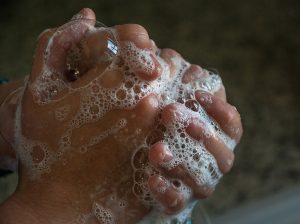Bulletin #4067, The ABCs of Hand Washing
Food Safety Facts
Originally prepared by Jane S. Harvey, State Coordinator for Child Care, University of Maine Cooperative Extension.
This fact sheet was formerly titled The Winner Against Infection: Hand Washing.
For information about UMaine Extension programs and resources, visit extension.umaine.edu.
Find more of our publications and books at extension.umaine.edu/publications/.
So much about hand washing seems almost insulting to parents and day-care providers. After all, you have cared for your own children and family very successfully without someone telling you to “turn off the faucet with the paper towel!” But evidence shows that children are much more likely to have and spread infection if they are cared for in groups of five and six. Once a cold, cough or diarrhea gets started, it can be passed around for weeks or even months. Consider these facts:
- The U.S. Department of Health and Human Services reported that hand washing is probably the single most important measure in preventing and stopping the transmission of hepatitis A and other intestinal tract illnesses.
- Starting back in the late 1800s, Dr. Ignaz Simmeliveis strictly enforced hand washing with chlorine. Within weeks, the mortality rate at the Vienna Lying-in Hospital dropped from 12 percent to 3 percent. Unfortunately, he did not publish his findings until 13 years later.
- Small children put things in their mouths, hold hands and pass cold viruses from person to person. In one Chicago nursery study, 77 percent of the children caught the same cold.
- Have children wash their hands frequently and be aware of any children who might be harboring a virus.
- Close physical contact, or more frequent encounters with virus-contaminated objects enables the virus to spread more easily.
- American adults have at least two colds each year. Children have as many as 12.
- Airborne fluids from sneezing and coughing contain germs that can live in the environment for at least several hours. These germs live on surfaces we touch—doorknobs, feeding trays, sink faucets and toys.
- Wash surfaces such as doorknobs, feeding trays, sink faucets and toys regularly.
Since there is no known cure for a cold (antibiotics do not help), prevention is the best attack against this virus. The first three-day period is the time when infection is the greatest threat to others.
Hands should be washed after any contact with fluids from the nose or mouth whether the child has a cold or not. Also, carefully dispose of paper tissues used to wipe noses, mouths or hands.
What is Proper Hand Washing?
It’s a myth that “a little is better than nothing” when it comes to hand washing. A bowl of soapy water passed around the table, a stream of water squirted on hands from a bottle or an abbreviated rinse under running water are not effective substitutes for careful hand washing.
The U.S. Center for Disease Controls (CDC) notes these guidelines for proper hand washing:
- Use soap and warm running water.
- Rub hands together vigorously.
- Wash all surfaces including the backs of hands, wrists, between fingers, and underneath fingernails.
- Rinse soap off hands in warm running water.
- Dry hands on a paper towel.
- Turn off the faucet with the used paper towel.
Child-care providers aren’t exempt from hand washing rules. You should wash your hands when you start work, before preparing food, after diapering a child, wiping a child’s nose, cleaning up messes or after a trip to the bathroom. For children, the routine is much the same.
The CDC recommends using paper rather than cloth towels. Bought in bulk, the brown institutional type are the most inexpensive. A hand washing program should include these practices:
- Provider modeling: Practice your routine in front of the children whenever possible.
- Supervision of hand washing: Observe as much as possible, especially when children are just learning how to do it correctly.
- Education: Provide fun activities for children and written material for parents to reinforce frequent and thorough hand washing.
It’s not always easy to make sure everybody washes and dries hands throughout the day, but it becomes automatic when added to your daily routine. In this way you can help children form good health habits that soon become part of their daily routine, too.
When and How to Wash Your Hands
When:
- Wash your hands before you touch food or as often as needed.
- Wash after you
- use the toilet,
- touch uncooked meat, poultry, fish or eggs or other food from animals,
- interrupt food preparation to answer the phone, open a door or drawer, etc.
- smoke,
- touch dirty plates, utensils or equipment,
- take out trash,
- touch your nose, mouth, or any part of your body,
- sneeze or cough,
- change diapers,
- touch pets.
- Use soap to scrub your hands.
- Use a clean cloth or paper towel to dry your hands.
How:
- Wet with warm water.
- Wash for 20 seconds.
- Rinse.
- Dry.
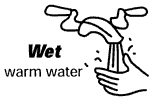
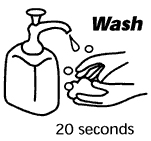
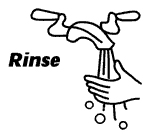
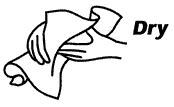
Adapted from UMass Extension Nutrition Education Program
For more information about food safety, call USDA’s Meat and Poultry Hotline at 1.800.535.4555 or contact your University of Maine Cooperative Extension county office.
Information in this publication is provided purely for educational purposes. No responsibility is assumed for any problems associated with the use of products or services mentioned. No endorsement of products or companies is intended, nor is criticism of unnamed products or companies implied.
© 2004
Call 800.287.0274 (in Maine), or 207.581.3188, for information on publications and program offerings from University of Maine Cooperative Extension, or visit extension.umaine.edu.
In complying with the letter and spirit of applicable laws and pursuing its own goals of diversity, the University of Maine System does not discriminate on the grounds of race, color, religion, sex, sexual orientation, transgender status, gender, gender identity or expression, ethnicity, national origin, citizenship status, familial status, ancestry, age, disability physical or mental, genetic information, or veterans or military status in employment, education, and all other programs and activities. The University provides reasonable accommodations to qualified individuals with disabilities upon request. The following person has been designated to handle inquiries regarding non-discrimination policies: Director of Equal Opportunity and Title IX Services, 5713 Chadbourne Hall, Room 412, University of Maine, Orono, ME 04469-5713, 207.581.1226, TTY 711 (Maine Relay System).


